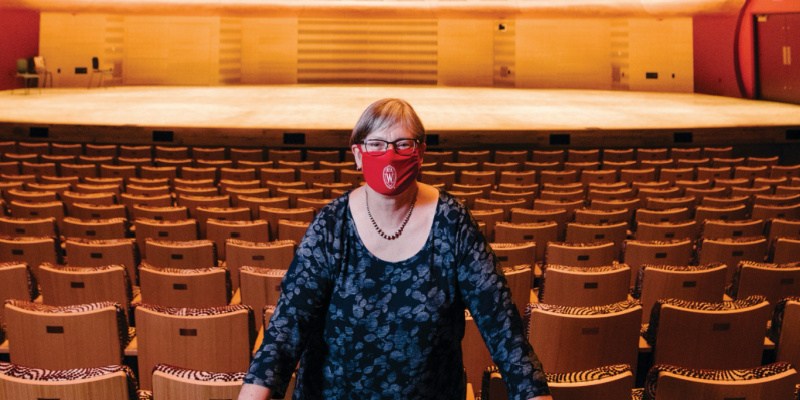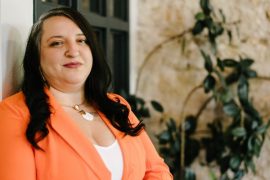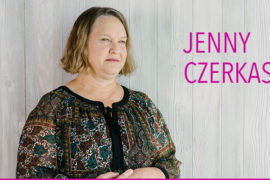By Masarah Van Eyck | Photography by Hillary Schave
If you watched that accordion-looking building go up over the past few years on University Avenue in downtown Madison, you have some idea of what Susan C. Cook, director of UW–Madison’s Mead Witter School of Music, has been up to.
Built entirely with private funds — the majority of which were secured under Cook’s leadership — the Hamel Music Center is the campus’s new state-of-the- art music performance hall. Pre-COVID-19 the school was offering dozens of public performances — many of them free — each month. Cook says the school is currently live-streaming events from the building (check the School of Music’s website) and they’re excited about their Zoom opera production this fall. (They’ll resume in-person performances when it’s “in accordance with all university, city and county guidelines,” explains Cook.)
Cook said it was sad to open the building in late October 2019 and then have to close it shortly after, but still, it’s a major addition for the music school. We asked her what it means to have brought such a venerable project to fruition.
As a musicologist, did you ever think you’d be directing a building project?
Absolutely not! And I don’t remember any [of my] graduate courses being offered on “building buildings.” However, interestingly enough, I did cross paths with the building’s architect, Malcolm Holzman, at my first faculty position at Middlebury College. I sat on the planning committee of their performance hall but left before any construction started.
What were some things you learned from working on this major building project?
It was such a fascinating project. I liked learning about things I didn’t know anything about, like precast concrete, which was chosen because it’s tough and gives acoustic support, but I had no idea how it had to be made in a mold and brought in, and you can choose the color of the material and all these little decisions that are just about the outside of the building. And how one thinks about building something that’s going to last, as well as something that’s beautiful. How you think about a building having a personality.
The other thing … was to hear different students talk about what they like about the building; things I didn’t think about that would be interesting or useful to them. One of the concerts that we did last year was a wind ensemble, and they talked about how that work wasn’t playable in our previous space, and I hadn’t put that together. I knew some things made [the Hamel building] different and special, but I didn’t know there was certain repertory we couldn’t play until we were in our new space.
Since you’ve been director, it seems the School of Music has hired faculty who bring new and/or contemporary perspectives to the department.
Well, music is a terrific way to engage with other cultures, past and present. All music won’t play to all crowds, but all crowds will play to some music.
Take for example Symphony Orchestra Director Oriol Sans, a native of Catalonia, Spain, who comes to Madison via Michigan. Or professors Jean Laurenz, Alicia Lee and Nadia Chana, whose backgrounds as accomplished performers and creative scholars bring modern and cross-cultural perspectives to their teachings. The more diverse offerings we can provide, the more powerful experiences and opportunities to better understand what it means to be human.
What are the overarching goals the music school has when it comes to diversity?
I think all music schools are faced with thinking about how they have historically defined what music they think is most important. Often times, those decisions [and] their ideas have been narrow. There’s a need for all of us to be expansive in all our listening and performing. If we only think some music is important, that’s going to limit and exclude. Of course, diversity in the student body is important and we want to see that reflected in the faculty and staff as well. There’s no one solution or one way to achieve that.
Of course, there’s always need for improvement. Most of my career I’ve been trying to work at curricular change and curricular development. Yes, we’ve made inroads, but there’s a tremendous amount of work to be done. I would be very suspicious of a place that said there wasn’t work to be done. Celebrate what you’ve done, but always make it clear that it’s a work in progress, and you can never stop doing the work of curricular change and curricular transformation.
Now that this project is wrapped, what’s next for you?
Good question! I’d love to see the momentum continue to get all of our activities moved out of the Mosse Humanities Building and into new instructional spaces that complement the state-of-the- art performance spaces of the Hamel Music Center.
On a personal note, however, I do want to get back to my own research and writing on American music, specifically, my work on ragtime dance. It draws on campus archives and uses campus activities to tell the story of what social dance and music meant to a youth audience in the years before World War I.




